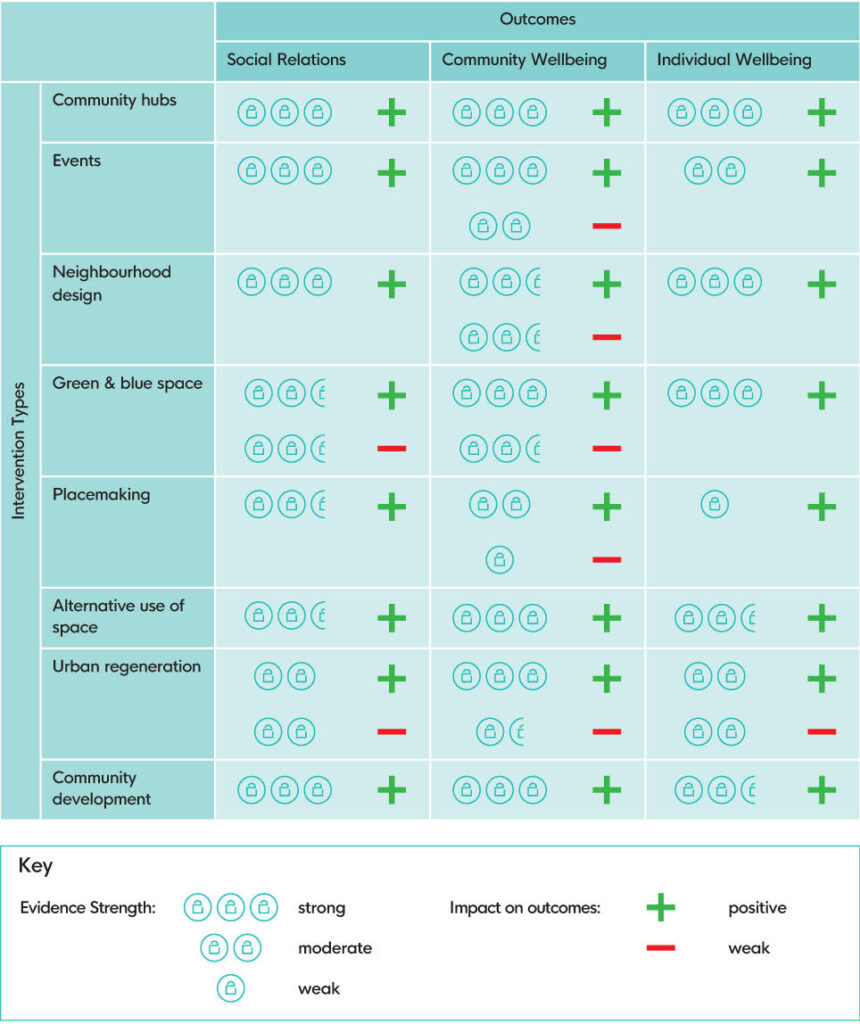In 2018, the What Works Centre for Wellbeing commissioned and published a review of how the changes made to community places and spaces impact our social relations and community wellbeing.
Five years on, and the same team from Leeds Beckett University, supported by the University of Liverpool, has revisited the evidence base to search for studies published since 2017.
The updated review, published today, combines new findings with those from the original report to produce stronger evidence, and a more detailed and nuanced analysis. Here, Stewart Martin takes us through the key insights and introduces the supporting publications.
The wellbeing evidence base is continually growing as more projects include wellbeing measurement. To capture these learnings, we commissioned a refresh of our 2018 Places, Spaces, People and Wellbeing review.
Our updated review includes a further 51 studies from 2017-2022, superseding the original and containing stronger evidence statements. We can more confidently say, for instance, that community hubs and community development have positive impacts on social cohesion, individual and community wellbeing.
Key findings
- Strong evidence for community hubs and community development improving social relations, individual and community wellbeing (evidence was moderate in 2018 review).
- Many interventions brought about both positive and negative impacts on wellbeing – for instance, local events can improve community wellbeing for many but have a detrimental impact on those they exclude (as also found in Different People, Same Place).
An overview of the findings can be seen in the table below, indicating the strength of the evidence and whether that evidence shows a negative, mixed or positive impact.
For more detail, visit the briefing webpage or download the full report.

What we did
We commissioned the same research team to review the evidence base that has developed over the past five years and combine their findings with those from the original review.
The team used the same parameters for their search as the original review, focusing upon changes to places and spaces at a neighbourhood level. They have combined the findings of the two searches and grouped them under the eight themes used in the original review.
Five years on – how has the evidence changed?
The original review drew on studies from 1997 to 2016. 51 were included in the final analysis, which provided promising evidence of positive impacts across eight themes. In contrast, the refresh added a further 51 studies, showing that the number of studies in this evidence base has doubled in five years.
Promising evidence has now been superseded by predominantly strong evidence, and for most of the themes that evidence is of positive impacts on social relations, community and individual wellbeing. It is important to note that the refresh included more evidence of mixed impacts.
For instance, while there was strong evidence that local neighbourhood events have a positive impact on community wellbeing (such as increased sense of belonging and pride through shared identity), we also found moderate evidence of some negative impacts (for example loss of shared identity, exclusion).
Not only does the refresh bring to light more evidence of mixed impacts, it also provides a possible reason for them:
- an increase in the projects which had both universal and targeted elements (more interventions in the original review focused on target areas or groups)
- an increase in activities that explicitly aimed to build social capital by mixing different communities.
In turn, this increase may be in response to recommendations to implement the public health equity model of ‘proportionate universalism’: to provide additional targeted programmes or adaptations for those with the poorest health or wellbeing while providing a broader offer that is available to all.
Another key feature of the past five years has been the COVID-19 pandemic. There was limited evidence relating to the pandemic and its impact, which could be because relevant studies are still yet to be published and because online interventions were out of the scope of the refresh.
The included studies that did reference COVID-19 highlighted the value of green and blue spaces and how the closure of some facilities (such as play parks and public toilets) made them less accessible. Improvements made by interventions were lost during the lockdown periods, some spaces became [more] contested with overcrowding, and some volunteering opportunities were curtailed. New volunteering opportunities arose and communities were quick to respond in adapting activities.
Will there be a further refresh of the evidence base in future?
This is dependent on funding. It is clear that the evidence base is developing fast and many of the recommendations made in this review point towards further research which could strengthen it further still.
In keeping with the original review, the refresh did not include virtual or hybrid spaces, and this is an area for further study.
Relatively few interventions from rural settings were found and we need to know more about those who do not participate in wellbeing interventions. Wellbeing measures need to be included in even more neighbourhood-level projects.
The larger and stronger this evidence base becomes, the more confident we can be in identifying what works.
Read further implications and recommendations in the briefing and full report.

